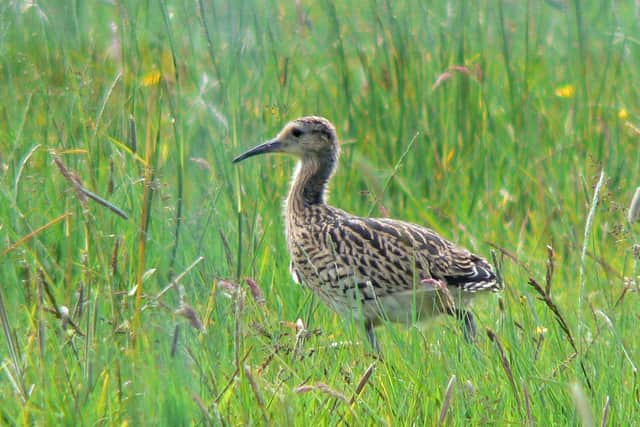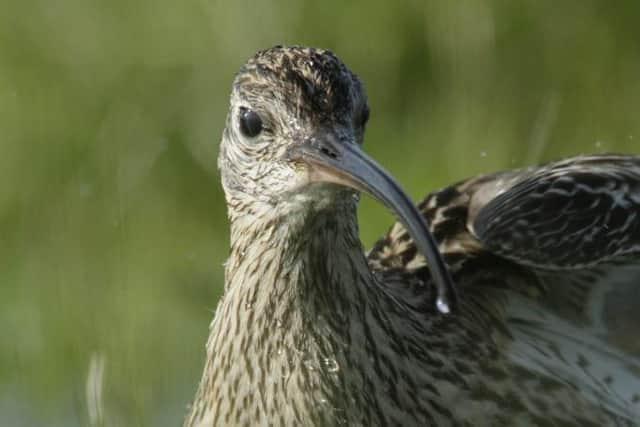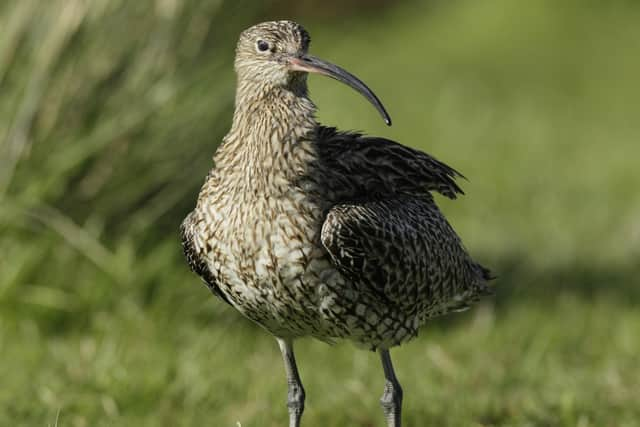Stunning curlew conservation success, as RSPB NI announces spectacular breeding results
and live on Freeview channel 276
The long-term decline in curlew numbers on the island of Ireland has worried conservationists and bird-lovers alike for many years. But now the latest breeding season in the Glenwherry area of the Antrim Plateau has sparked real hope for a recovery of its numbers in Northern Ireland. This conservation success didn’t happen by accident. The incredible results are down to a combination of tireless habitat management by farmers and landowners in the area, supported by advice and hands-on conservation work by RSPB NI.
A phenomenal 69 fledged curlew chicks were recorded in Glenwherry this season, building on last year’s 28 chicks, which was itself a record. A further 11 chicks, at least, fledged from RSPB NI’s Lower Lough Erne Reserve. So, in total, at least 80 curlew chicks in Northern Ireland were helped by conservation practices being carried out by farmers, landowners, and the charity on working farmland. These results mark a huge environmental success when you consider that it’s estimated that there are less than 200 pairs of this iconic species left in Northern Ireland. Increasing and maintaining breeding success is vital to the restoration of the curlew population to a healthy state.
Advertisement
Advertisement
The secret to this amazing conservation success is down to the partnership between the charity and the local farmers. This partnership has been at the core of ensuring the right habitat management was put in place to bring about these impressive results. Since the 1990’s, RSPB NI has been advising and supporting farmers in Glenwherry to take steps to restore and protect these iconic species on their land, ensuring that land managers have the right advice and support to farm in nature friendly ways.


Katie Gibb, conservation officer for RSPB NI working on the Antrim Plateau said, “With the addition of a few pairs turning up with ‘surprise’ chicks, we followed 28 broods of curlew chicks, of these an unheard of 22 made it to fledge. This is a massive increase from the 14 broods fledging last season.
“However, it was the number of individual chicks that made it to fledge that has put this season over and above anything that we ever thought was possible. This year we had an amazing count of 69 fledglings. To put this into context, within the first two years of the Curlews in Crisis project in conjunction with the Department of Agriculture, Environment and Rural Affairs’ (DAERA) Environmental Farming Scheme (EFS) group option, we managed to get a total of 98 chicks fledged; this is more chicks than the site produced in the previous seven years combined.”
Targeted projects on site under DAERA’s Environmental Farming Scheme group option has also allowed farmers to implement nature-friendly farming principles on their land. Group options such as this, which allow knowledge sharing, peer support and encourage a landscape scale approach to conservation, as well as support from projects such as Curlews in Crisis; a four-year LIFE Nature project co-funded by the EU LIFE programme, the Northern Ireland Environment Agency (NIEA), and other statutory bodies and local partners across the UK have been essential in seeing these conservation principles become a reality.
Advertisement
Advertisement
To maintain population stability, the average breeding curlew pair needs to produce one fledged chick every two years; however, that hasn’t happened for many years. This year, RSPB NI’s Glenwherry season has beaten this goal by a large margin, 37 pairs were monitored in the conservation area, fledging a total of 69 chicks. These amazing results have come just in time. The number of curlews returning to breed in the Glenwherry area of the Antrim Plateau has been gradually decreasing in recent years. These results give fresh hope that improved numbers of breeding pairs will return to the site in future years.


The Eurasian curlew is a much-loved species in Northern Ireland, its call and striking silhouette are known to many as an iconic part of our upland farmland, lowland wetlands, and coastal areas. Sadly, these remarkable birds are in real trouble with their population declining by 82% since 1987 due to low breeding productivity caused by habitat loss and degradation, as well as loss of eggs and chicks to predation. Without intervention, this species is predicted to be extinct in Northern Ireland within the next ten years.
Katie Gibb continued: “Curlews are a cryptic species, meaning they are highly camouflaged in their habitat, so nest finding is a skilled practice. EU LIFE and DAERA funding has allowed RSPB NI to survey almost 8,000 hectares of upland farms and grassland in the Antrim Plateau for curlews, locating their nests, and monitoring them for signs of breeding, such as indications of nest building or ‘changeover events’, when the parents swap over incubation shifts on the nest. These searches can take days of meticulous surveying of the site, as a missed nest could mean the loss of a clutch of eggs very quickly.”
As this site hosts one of the most vulnerable populations of curlew in Northern Ireland, alongside ongoing habitat management, emergency short-term interventions were carried out under NIEA licence by the charity’s conservation officers to protect the breeding pairs, throughout the season. This included temporary electrified fences being erected around the nests, ensuring protection from ground predators at the most vulnerable egg stage. As predation is known to be one of the major factors contributing to this species’ population declines, these fences were combined with targeted predator control to give the chicks a fighting chance to survive.
Advertisement
Advertisement
“It really is a case of every chick counts when it comes to curlew in Northern Ireland. This year saw us install one of the highest number of targeted nest fences at a single site in the UK. The fences, and knowledge of the pairs gathered from previous seasons, have been a game-changer for curlew conservation on our site, and allowed us to see an increase in hatching rates from around 40% to 70%, marking a real turning of the tide for curlew conservation on the Antrim Plateau.


“What this season means is that in the next five years we could have over 30 new pairs return to the area to breed, which would be a massive and healthy influx of young, fertile, new genetics for this population. The number of chicks we have seen fledge this year is not just heartening, it is unequivocable proof that conservation and landscape-scale nature protection works and should remain a priority in tackling the biodiversity crisis.”
Meanwhile in Co Fermanagh, RSPB NI recorded further encouraging statistics. Their reserve on Lower Lough Erne supports critical populations of breeding waders, recording some of the highest breeding densities anywhere in the UK. However, monitoring of the islands on the second largest freshwater lake in the UK is logistically challenging and takes a very different form from that on the farms and uplands of the Antrim Plateau, making accurate counts of fledglings difficult. This year saw the Lower Lough Erne team monitor a total of 36 pairs of curlews across 200 hectares of lowland wet grassland.
Amy Burns, estate manager for RSPB NI on Lower Lough Erne Islands Reserve said: “Monitoring of the islands is logistically challenging due to nest densities and the complexity of monitoring across the many islands of the Reserve making accurate counts of fledglings difficult here.
Advertisement
Advertisement
“A total of 23 pairs of curlew were recorded hatching young this season in this area, with 18 nests located, 17 of which successfully hatched full clutches. We had an unbelievable four nests synchronously hatching on one island on the same day in May. We utilise remote camera technology to give us a unique glimpse into the life of curlew on the islands. We’ve been able to capture images and videos of young chicks, adults and fledglings as well as thousands of selfies of curious highland cows. We believe the 11 recorded fledglings this season may only be a proportion of the overall number which could have fledged from our reserve this year.”